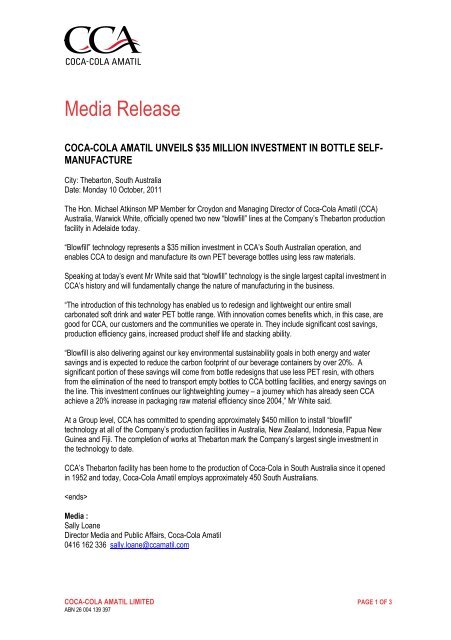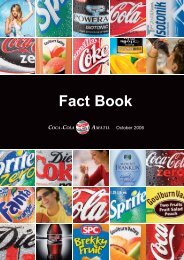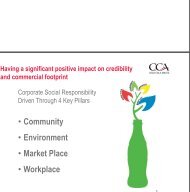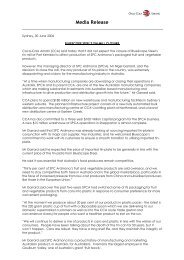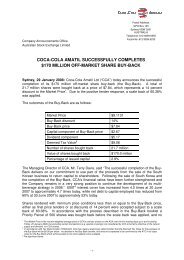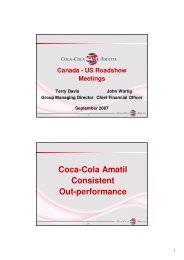Media Release - Coca-Cola Amatil
Media Release - Coca-Cola Amatil
Media Release - Coca-Cola Amatil
You also want an ePaper? Increase the reach of your titles
YUMPU automatically turns print PDFs into web optimized ePapers that Google loves.
<strong>Media</strong> <strong>Release</strong><br />
COCA-COLA AMATIL UNVEILS $35 MILLION INVESTMENT IN BOTTLE SELF-<br />
MANUFACTURE<br />
City: Thebarton, South Australia<br />
Date: Monday 10 October, 2011<br />
The Hon. Michael Atkinson MP Member for Croydon and Managing Director of <strong>Coca</strong>-<strong>Cola</strong> <strong>Amatil</strong> (CCA)<br />
Australia, Warwick White, officially opened two new “blowfill” lines at the Company’s Thebarton production<br />
facility in Adelaide today.<br />
“Blowfill” technology represents a $35 million investment in CCA’s South Australian operation, and<br />
enables CCA to design and manufacture its own PET beverage bottles using less raw materials.<br />
Speaking at today’s event Mr White said that “blowfill” technology is the single largest capital investment in<br />
CCA’s history and will fundamentally change the nature of manufacturing in the business.<br />
“The introduction of this technology has enabled us to redesign and lightweight our entire small<br />
carbonated soft drink and water PET bottle range. With innovation comes benefits which, in this case, are<br />
good for CCA, our customers and the communities we operate in. They include significant cost savings,<br />
production efficiency gains, increased product shelf life and stacking ability.<br />
“Blowfill is also delivering against our key environmental sustainability goals in both energy and water<br />
savings and is expected to reduce the carbon footprint of our beverage containers by over 20%. A<br />
significant portion of these savings will come from bottle redesigns that use less PET resin, with others<br />
from the elimination of the need to transport empty bottles to CCA bottling facilities, and energy savings on<br />
the line. This investment continues our lightweighting journey – a journey which has already seen CCA<br />
achieve a 20% increase in packaging raw material efficiency since 2004,” Mr White said.<br />
At a Group level, CCA has committed to spending approximately $450 million to install “blowfill”<br />
technology at all of the Company’s production facilities in Australia, New Zealand, Indonesia, Papua New<br />
Guinea and Fiji. The completion of works at Thebarton mark the Company’s largest single investment in<br />
the technology to date.<br />
CCA’s Thebarton facility has been home to the production of <strong>Coca</strong>-<strong>Cola</strong> in South Australia since it opened<br />
in 1952 and today, <strong>Coca</strong>-<strong>Cola</strong> <strong>Amatil</strong> employs approximately 450 South Australians.<br />
<br />
<strong>Media</strong> :<br />
Sally Loane<br />
Director <strong>Media</strong> and Public Affairs, <strong>Coca</strong>-<strong>Cola</strong> <strong>Amatil</strong><br />
0416 162 336 sally.loane@ccamatil.com<br />
COCA-COLA AMATIL LIMITED PAGE 1 OF 3<br />
ABN 26 004 139 397
<strong>Media</strong> <strong>Release</strong><br />
FACT SHEET - <strong>Coca</strong>-<strong>Cola</strong> <strong>Amatil</strong> (CCA) investment in “Blowfill” technology<br />
General<br />
CCA’s group-wide $450 million investment in “blowfill” technology – or bottle self-manufacture –<br />
is the largest infrastructure investment for the Company in a decade.<br />
“Blowfill” technology is being installed across CCA’s production facilities in Australia, New<br />
Zealand, Indonesia, Papua New Guinea and Fiji.<br />
“Blowfill” technology has enabled CCA to redesign and lightweight its entire small carbonated soft<br />
drink and water PET bottle range, delivering significant cost savings, production efficiency gains,<br />
increased product shelf life and stacking ability.<br />
“Blowfill” is delivering against key environmental sustainability goals in both energy and water<br />
savings as it has enables CCA to produce PET bottles using less resin, with lighter labels, and<br />
shorter, redesigned closures/caps that are without a liner.<br />
The change in production process will lead to a reduction in the use of cardboard and shrink<br />
plastic in secondary packaging, significant savings in water use as the “blowfill” bottles do not<br />
need to be rinsed prior to filling, and the future capacity to save energy in the “blowing” of the preforms<br />
into bottles by introducing low-pressure blowing.<br />
“Blowfill” technology is expected to reduce the carbon footprint of CCA’s beverage containers by<br />
over 20%, with a significant portion of these savings coming from bottle redesigns that use less<br />
PET resin, but also from the elimination of the need to transport empty bottles to CCA bottling<br />
facilities, and energy savings on the line.<br />
A 2011 Masters study of “blowfill” technology at CCA’s Northmead, Sydney site – the first site to<br />
introduce “blowfill” – found that the technology has delivered a remarkable 22% reduction in the<br />
carbon footprint for every beverage container, based on an average 600mL bottle size (source:<br />
Martina Birk – MSc Thesis “Case study - <strong>Coca</strong>-<strong>Cola</strong> <strong>Amatil</strong>, Australia: Comparison of carbon<br />
footprint converter model v blow-fill technology for PET bottles” August 2011). This is equivalent<br />
to 1700 cars being removed from the roads per year.<br />
Ms Birks’ study found that the most significant carbon savings are delivered by:<br />
Using 15-23% less PET resin in all bottle manufacture<br />
Using 33% less PET resin in closures (or caps)<br />
Using 30% less energy used to “blow” the pre-forms into bottles<br />
Eliminating use of the warmer (the new technology enables bottles to be filled at room<br />
temperature)<br />
Reducing the transportation of bottles from suppliers<br />
CCA estimates that more than 9000 tonnes of PET resin will be saved per year when all<br />
production lines have installed “blowfill” technology.<br />
“Blowfill” continues CCA’s lightweighting journey, a journey that has already seen CCA achieve a<br />
20% increase in raw material efficiency since 2004 when 1 tonne of PET resin produced 38,000<br />
bottles compared to the 46,500 today.<br />
COCA-COLA AMATIL LIMITED PAGE 2 OF 3<br />
ABN 26 004 139 397
<strong>Media</strong> <strong>Release</strong><br />
Thebarton<br />
<br />
<br />
<br />
<br />
The $35 million investment in CCA’s Thebarton production facility is the Company’s largest<br />
investment to date in “blowfill” technology.<br />
The Thebarton facility has been home to the production of <strong>Coca</strong>-<strong>Cola</strong> in South Australia since it<br />
opened in 1952 and today, it produces the full CCA range of beverages including brands under<br />
licence from The <strong>Coca</strong>-<strong>Cola</strong> Company (major brands include <strong>Coca</strong>-<strong>Cola</strong>, <strong>Coca</strong>-<strong>Cola</strong> Zero, diet<br />
Coke, Sprite, Fanta, Glaceau vitamin water, Powerade Isotonic, Mother energy drink), along with<br />
CCA-owned brands.<br />
The Thebarton facility produces approximately 110 million PET bottles a year.<br />
<strong>Coca</strong>-<strong>Cola</strong> <strong>Amatil</strong> employs 450 South Australians with the Thebarton facility being the main<br />
workplace for 240 employees.<br />
COCA-COLA AMATIL LIMITED PAGE 3 OF 3<br />
ABN 26 004 139 397


